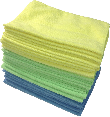There are times when, no matter how hard we try, calcium deposits simply "appear" on our cookware. Most often this phenomenon is noticed on stainless steel cookware. There are several methods that you can use to help in removing calcium deposits from cookware, though most of them require that you think outside the box a little bit. In fact, some of them may even seem a little counter intuitive, but they do work.
While these methods will work for a vast majority of calcium deposits, there is a chance that they won't as well. That situation is usually due to the metal becoming so pitted from use that there really isn't anything that you can do to restore the damaged steel pot. It is best to avoid such a situation by preventing it from happening at all. Do this by being careful with the amount of salt that you use in your cooking, and if at all possible avoid adding salt at all. If you do need to add any salt, only add it after the water has stopped boiling.

The Power of Microfiber! Zwipes Microfiber Cleaning Cloths will become your favorite tool for every cleaning task. This 36-cloth package is perfect for hundreds of uses in the garage, kitchen, bathroom, laundry, and all around the house. Each cloth is tough, streak-free, lint-free, reusable, and washable. Check out Microfiber Cleaning Cloths today!
Have you ever noticed how difficult it can be to get rid of burnt chili? For some reason removing burnt chili is a fairly ...
Discover MorePerhaps one of the worst smelling, and most difficult, messes to clean up is burnt rice. For some reason removing burnt ...
Discover MoreCrystal is beautiful, but it can easily develop spots caused by hard water. Vinegar can be an effective way to fix this ...
Discover MoreFREE SERVICE: Get tips like this every week in Cleaning Tips from Tips.Net. Enter your address and click "Subscribe."
There are currently no comments for this tip. (Be the first to leave your comment—just use the simple form above!)
FREE SERVICE: Get tips like this every week in Cleaning Tips from Tips.Net. Enter your address and click "Subscribe."
Copyright © 2025 Sharon Parq Associates, Inc.
Comments